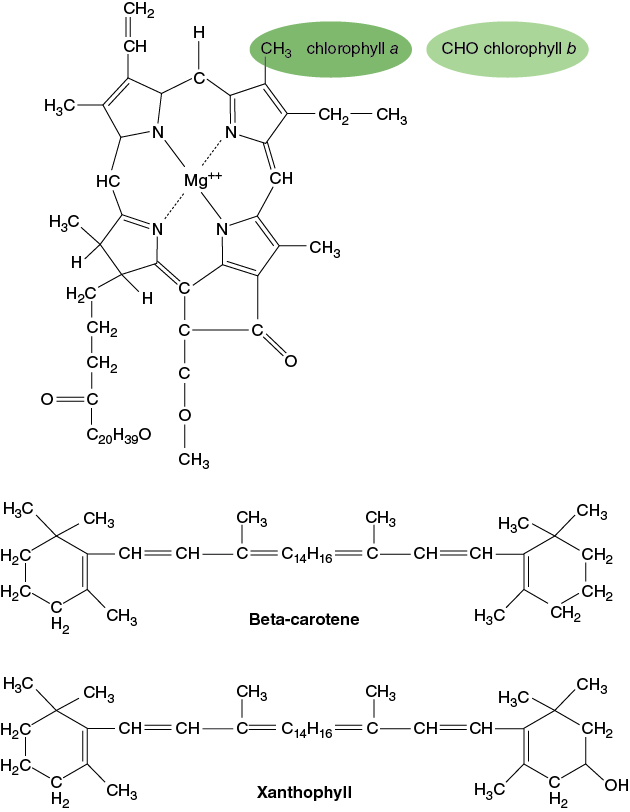Chapter 2. Carbon Metabolism: Light and Photosynthetic Pigments
General Purpose
This pre-lab will present some of the general concepts related to the process of paper chromatography.
Learning Objectives
General Purpose
Conceptual
- Have a general understanding of how a mixture of photosynthetic pigments can be separated from each other by the technique of paper chromatography.
- Know what characteristics of the pigment molecules are important in determining their rates of movement in the technique of paper chromatography.
Procedural
- Gain a proficiency in a chromatographic technique.
Background Information
Chloroplasts of most plants contain several photosynthetic pigments: chlorophyll a, a blue-green pigment; chlorophyll b, a yellow-green pigment; xanthophylls, yellow pigments; and carotenes, yellow-orange pigments (Figure 7-3).
These pigments are embedded in the thylakoid membranes of the chloroplasts. Both chlorophyll a and chlorophyll b are large molecules with a central core of magnesium held in a porphyrin ring. In both types of chlorophyll the porphyrin ring is attached to a long, hydrocarbon tail that anchors the molecules to the thylakoid membranes. Chlorophyll a and b have identical chemical structures, except chlorophyll b has a –CHO group in place of the –CH3 group as indicated by the circle in Figure 7-3. The carotene and xanthophyll molecules are mainly hydrocarbon chains, with alternating single and double bonds between carbons and ring structures at either end of the chain. The xanthophylls and carotenes have a very nonpolar molecular nature that makes their integration into the thylakoid membranes possible.

The individual pigments can be observed by separating them using a technique known as chromatography. This process can separate complex mixtures into their component parts. All chromatographic systems consist of a mobile phase and a stationary phase. Molecules are separated by the differences between their affinities for the two phases. Molecules with a strong attraction for the mobile phase move with the mobile phase; those with a strong attraction for the stationary are inhibited from moving in the mobile phase.
The technique of paper chromatography is based on the relative solubility of the molecules in the mixture to various kinds of solvents and their affinity or attraction to the chromatography paper. As the solvent moves up the paper by capillary action, it carries along substances (i.e., the pigments) dissolved in it. The pigments move at different rates because they are not equally soluble in the solvent and because they are attracted, to different degrees, to the cellulose in the paper.
Use the following generalizations regarding the paper chromatography technique and the molecular structures of the photosynthetic pigments (Figure 7-3) to predict the relative separation pattern for the pigments.
- The chromatography paper is a polar substance.
- The chromatography solvent (petroleum ether and acetone) is nonpolar.
- Polar substances dissolve in (or are attracted to) polar molecules.
- Nonpolar substances dissolve in nonpolar solvents.
- The most nonpolar pigment will travel with the solvent front.
- The most polar pigment will stay in place (move last), bound to the paper.
In your laboratory notebook make a sketch of Figure 7-4 showing the predicted order of the pigments you should see on the chromatogram upon completion of the paper chromatography.
Pre-Lab Quiz
Proceed to the Pre-Lab Quiz